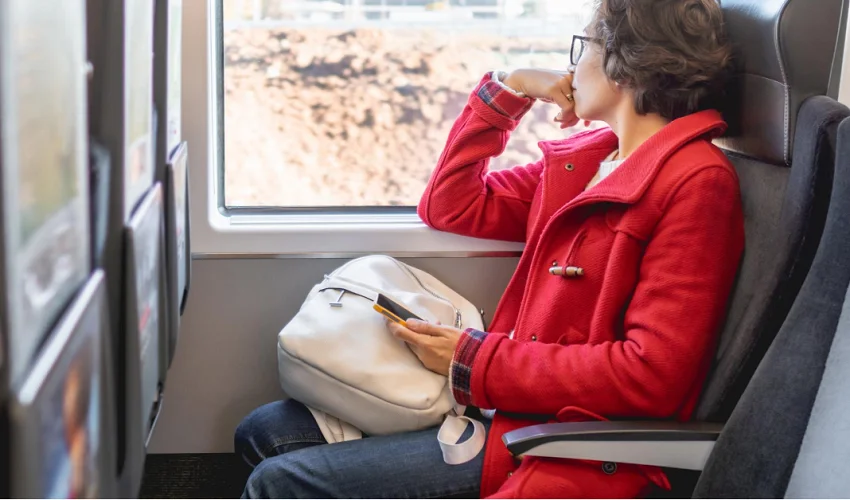Traveling can be an exciting experience, but for individuals with diabetes, it requires careful planning and management to ensure their health and well-being during the journey. Whether you are on a plane, train, or embarking on a long-distance journey, it is essential to take certain precautions to effectively manage your diabetes. This article aims to provide type 2 diabetic patients and caregivers with valuable tips and strategies to maintain optimal blood sugar levels, manage medications, and prioritize their overall health while traveling. By following these guidelines, individuals with diabetes can enjoy their travel experiences while minimizing potential complications.
Preparing for the Journey
Before embarking on your journey, adequate preparation is crucial to ensure a smooth travel experience with diabetes.
Consult with Your Healthcare Provider
It is advisable to consult with your healthcare provider well in advance of your trip. They can offer personalized advice based on your individual health needs and make any necessary adjustments to your diabetes management plan. Your healthcare provider can also provide you with a letter detailing your condition and required medications, which can be useful during security checks or in case of emergencies.
Traveling with diabetes requires planning and preparation to ensure a smooth journey. Consultation with your healthcare provider is essential to address any concerns or make necessary adjustments to your diabetes management plan. They can provide personalized advice based on your specific health needs, taking into consideration factors such as your current medication regimen, dietary requirements, and activity levels. By discussing your travel plans with your healthcare provider, you can receive valuable guidance on managing your diabetes effectively while on the move. Additionally, they can provide you with a letter that outlines your condition, required medications, and any special considerations. This letter can be beneficial during security checks or in case of emergencies, ensuring smooth communication with relevant authorities.
Plan Your Meals and Snacks
Maintaining a balanced and consistent meal plan is important for managing blood sugar levels. When traveling, it may be challenging to access suitable food options at all times. Therefore, consider packing a variety of nutritious snacks such as fresh fruits, vegetables, nuts, and whole-grain crackers. These snacks can be convenient and help stabilize your blood sugar levels during the journey.
Managing your diabetes effectively while traveling involves careful planning of your meals and snacks. It is important to maintain a balanced and consistent meal plan to help regulate your blood sugar levels. However, finding appropriate food options while on the move can be challenging. To ensure that you have access to suitable snacks throughout your journey, consider packing a variety of nutritious options in your carry-on bag. Fresh fruits, vegetables, nuts, and whole-grain crackers are excellent choices that provide essential nutrients and help keep your blood sugar levels stable. By planning your meals and snacks in advance, you can maintain better control over your diabetes during your travels.
Carry Enough Medications and Supplies
Ensure that you have an ample supply of all necessary diabetes medications, including insulin, oral medications, glucose-lowering agents, and any other prescribed medications. It is wise to carry extra supplies in case of unexpected delays or emergencies. Keep medications in your carry-on luggage to ensure they are easily accessible during the journey.
When traveling with diabetes, it is vital to carry an adequate supply of your prescribed medications and diabetes supplies. Make a checklist to ensure you have enough insulin, oral medications, glucose-lowering agents, and any other necessary medications for the duration of your trip. Consider packing extra supplies to account for unexpected delays or loss of items. It is crucial to keep your medications in your carry-on luggage rather than checked baggage to ensure easy access. In the event of lost luggage, you will still have your essential diabetes medications and supplies readily available.
Wear a Medical ID
Wearing a medical ID bracelet or necklace that identifies you as a person with diabetes is highly recommended. In case of an emergency, this can provide critical information to medical personnel who may not be familiar with your condition.
Wearing a medical ID is a simple yet effective way to communicate your diabetes status to medical professionals in case of an emergency. In situations where you may be unable to provide accurate information about your medical condition, a medical ID can quickly alert medical personnel to your diabetes diagnosis. It is advisable to wear a medical ID bracelet or necklace that clearly states your name, diabetes diagnosis, and any specific medical instructions, such as the need for insulin or any allergies you may have. This helps ensure that you receive appropriate care promptly and minimizes the risk of medical complications.
Managing Diabetes during the Journey
Once you have prepared for the journey, it is important to implement certain strategies while traveling to effectively manage your diabetes.
Stay Hydrated
Proper hydration is crucial, especially during long journeys. Drink plenty of water and avoid sugary beverages or excessive alcohol consumption, as they can lead to dehydration and affect your blood sugar levels.
Staying hydrated is essential for maintaining overall health, especially during travel. Make a conscious effort to drink plenty of water throughout your journey to prevent dehydration. Carry a refillable water bottle and ask for water whenever it is available. Avoid sugary beverages and excessive alcohol consumption, as they can cause dehydration and potentially disrupt your blood sugar control. By prioritizing hydration, you can help regulate your blood sugar levels and support your body’s overall function.
Monitor Blood Sugar Levels Regularly
Frequent monitoring of your blood sugar levels is essential while traveling. Carry a portable blood glucose meter and testing supplies with you, and make it a habit to check your blood sugar levels at regular intervals. This will allow you to make appropriate adjustments to your diabetes management plan, such as adjusting medication doses or modifying your meal plan if necessary.
Regular monitoring of your blood sugar levels is crucial for maintaining optimal diabetes control while traveling. Carry a portable blood glucose meter and sufficient testing supplies with you during your journey. Aim to check your blood sugar levels at regular intervals, as the stress, changes in meal times, and activity levels during travel can affect your blood sugar levels. By monitoring your blood sugar, you can make informed decisions regarding your diabetes management. If necessary, adjust your medication doses or modify your meal plan to maintain stable blood sugar levels. Regular monitoring empowers you to take control of your diabetes and ensure your well-being during the journey.
Be Mindful of Time Zone Changes
If you are crossing different time zones during your journey, it is important to consider the impact on your diabetes management. Consult with your healthcare provider regarding the adjustment of medication schedules to align with the new time zone. Maintaining regular meal times can also help in managing blood sugar levels effectively.
Traveling across multiple time zones can disrupt your diabetes management routine. Consult with your healthcare provider to determine the best approach for adjusting your medication schedules when transitioning to a new time zone. They can provide guidance on the appropriate timing and dosage adjustments for insulin or oral medications. Additionally, maintaining regular meal times as much as possible can help regulate your blood sugar levels during the transition. By being mindful of time zone changes and adapting your diabetes management accordingly, you can minimize the potential impact on your blood sugar control.
Stay Active
Sitting for extended periods during travel can lead to decreased circulation and potentially affect blood sugar control. Whenever possible, get up and move around the cabin or train compartment. Stretching your legs, doing simple exercises, or taking short walks can help improve circulation and maintain healthier blood sugar levels.
Prolonged periods of inactivity during travel can contribute to reduced blood circulation and impact blood sugar control. To counteract the effects of prolonged sitting, make an effort to stay active whenever possible. Take short walks up and down the aisle of the plane or train, stretch your legs while standing or sitting, and perform simple exercises to keep your body moving. These activities can help improve blood circulation, prevent blood clots, and support better blood sugar control. If permitted, consider taking short breaks during layovers to engage in more extensive physical activity. By incorporating regular movement into your travel routine, you can promote better overall health and diabetes management.
Navigating Air Travel with Diabetes
Traveling by air presents its own set of challenges for individuals with diabetes. Here are specific tips to manage your diabetes during air travel:
Prepare for Security Checks
Inform security personnel that you have diabetes and provide them with your medical letter if needed. Make sure your diabetes supplies, such as insulin pens, syringes, and lancets, are properly labeled and organized in your carry-on bag for easy inspection.
As you navigate through airport security checks, it is important to inform the security personnel that you have diabetes. If requested, present your medical letter, which outlines your condition and required medications. This will help them understand the need for certain medical supplies and prevent any unnecessary delays or confusion. Ensure that your diabetes supplies, including insulin pens, syringes, and lancets, are properly labeled and organized in your carry-on bag for easy inspection. By being prepared and proactive, you can streamline the security process and ensure that you have everything you need for managing your diabetes during your flight.
Carry Snacks and Medications
Pack your diabetes-friendly snacks and medications in your carry-on luggage. Keep in mind that air travel regulations may limit the quantity of liquids or gels you can carry, so check with your airline in advance to understand their specific policies.
When traveling by air, it is essential to pack diabetes-friendly snacks and medications in your carry-on luggage. This ensures that you have easy access to these items throughout your journey. However, it is important to note that air travel regulations may restrict the quantity of liquids or gels you can carry. To comply with these regulations, check with your airline in advance to understand their specific policies regarding diabetic supplies and medications. Pack snacks that are not subject to these restrictions, such as fresh fruits, nuts, or whole-grain crackers. By carrying your own snacks and medications, you can maintain control over your blood sugar levels and minimize the risk of experiencing a hypoglycemic episode or becoming unwell due to inadequate food options.
Adjust Insulin Regimen for Long Flights
For long flights, it may be necessary to adjust your insulin regimen. Consult with your healthcare provider to determine if any modifications are required to accommodate changes in mealtimes or activity levels during the flight.
Long flights can present unique challenges for managing diabetes, particularly regarding insulin administration. Changes in meal schedules, time zone transitions, and reduced activity levels may necessitate adjustments to your insulin regimen. Consult with your healthcare provider well in advance of your trip to discuss potential modifications to your insulin doses or timing. They can provide recommendations based on your individual needs and help ensure that your insulin management remains consistent throughout the journey. By proactively addressing these considerations, you can maintain stable blood sugar levels and prevent potential complications during long flights.
Ensuring Safety and Well-being
Apart from managing your diabetes during travel, prioritizing your overall safety and well-being is crucial.
Communicate with Travel Companions
If you are traveling with others, ensure they are aware of your diabetes, its symptoms, and what to do in case of an emergency. Inform them about the location of your medications and supplies in case you require assistance.
When traveling with companions, it is essential to communicate your diabetes diagnosis, its symptoms, and necessary emergency procedures. Educate them about the signs of hypoglycemia and hyperglycemia, as well as appropriate actions to take in case of an emergency. Share information about the location of your diabetes medications and supplies, so they can assist you if needed. This open communication ensures that your travel companions can provide support and help address any diabetes-related concerns that may arise during the journey.
Stay Prepared for Emergencies
Pack a small emergency kit that includes extra diabetes supplies, glucose tablets or gel, and a glucagon emergency kit if prescribed by your healthcare provider. Familiarize yourself with the symptoms and treatment of hypoglycemia (low blood sugar) and hyperglycemia (high blood sugar) to respond promptly if needed.
Emergencies can happen at any time, so it is important to be prepared. Pack a small emergency kit that includes extra diabetes supplies, such as testing strips, lancets, and insulin if applicable. Include glucose tablets or gel to quickly raise your blood sugar in case of a hypoglycemic episode. If your healthcare provider has prescribed a glucagon emergency kit, ensure that it is also included in your emergency supplies. Familiarize yourself with the symptoms and treatment of both hypoglycemia and hyperglycemia, so you can respond promptly if needed. By staying prepared, you can effectively manage unexpected diabetes-related situations and ensure your well-being during the journey.
Research Medical Facilities at Your Destination
Before your trip, research and identify medical facilities or hospitals at your destination. Note their contact information and addresses in case you need medical assistance while traveling.
It is wise to conduct research on medical facilities or hospitals at your travel destination. Identify their contact information, addresses, and proximity to your accommodations. This information can be valuable in case you require medical assistance or consultation during your journey. Having the details readily available can save time and reduce stress in case of a medical emergency or unforeseen health issue. By being prepared and aware of the medical resources available, you can ensure that you receive prompt and appropriate care if the need arises.
By implementing the tips and strategies outlined in this article, individuals with type 2 diabetes can effectively manage their condition while traveling on a plane, train, or long-distance journey. Prioritizing preparation, monitoring blood sugar levels, maintaining a balanced meal plan, and staying active are key elements to ensure a safe and enjoyable travel experience. Remember, it is important to consult with your healthcare provider to personalize your travel plan based on your individual needs. With proper care and planning, individuals with diabetes can embark on their journeys confidently, exploring new destinations while keeping their health in check.




